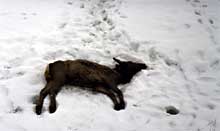
|
Lobby > Exhibits > Hot Spring Ecology > Wildlife > Hydrothermal Hazards WildlifeHYDROTHERMAL HAZARDS
Although the combination of events leading to such events is rare, buildup of hydrogen sulfide and carbon dioxide has been responsible for the deaths of bison, elk, bear, and small mammals during in past 100 years. In 1939, an employee of the Bureau of Public Roads was killed by a high concentration of hydrogen sulfide in a 26 foot (8 m) deep pit near Tower Junction. Carbon dioxide, which is odorless, may also have contributed to his death. After the 1939 fatality, all the caves in the Mammoth area were closed to park visitors, including the popular tourist attraction, Devil’s Kitchen. Carbon dioxide frequently kills birds, insects, and small animals in such areas.  Next | 1 > 2 > 3 > 4 > 5 > 6 | Next Section: Plants |
|
||||||||||||||||||||||||||||||
 Extremely cold weather may cause the steam and toxic gases of a thermal area to remain close to the ground and settle into topographically low areas.
Extremely cold weather may cause the steam and toxic gases of a thermal area to remain close to the ground and settle into topographically low areas. 
